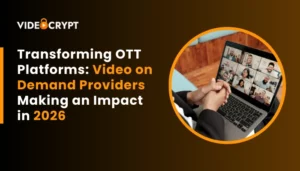Video marketing is the future of marketing. Consumption of video content has skyrocketed since the pandemic. Short-form video platforms have taken over everyone’s screens. Anywhere you scroll, someone is either doing a get-ready-with-me (GRWM) video or demonstrating how effective a new gadget is.
The importance of interactive short-form videos has been recognized by brands and marketers globally. 91% of businesses use videos as a marketing tool these days. Of those, 92% are satisfied with the ROI of their video marketing endeavors. People around the world spend hundreds of hours every day watching some kind of video content.
The benefits of video marketing continue to expand. One of the value additions of video marketing is in the domain of CLV. CLV stands for Customer Lifetime Value. CLV is an integral metric in business marketing.
Businesses use targeted promotional offers, customer service, and many other ways to increase the CLV of their customers. In light of changing market trends and user preferences, video marketing is becoming a key player in strengthening and advancing customer lifetime value for brands.
Let us first understand what CLV is.
Table of Contents
ToggleWhat is CLV?
Customer Lifetime Value (CLV) refers to the total profit/revenue that a customer generates for a company during the complete course of their relationship. In simpler terms, CLV measures the total amount of money a customer has spent on your services.
How is CLV calculated?
Several formulas calculate customer lifetime value. Based on the service, monetization model, and many other factors, a business may choose the formula that best helps it aggregate the revenue generated by a customer.
Without taking a detour to your high school math class, we will focus on the simplest formula that calculates customer lifetime value.
To calculate CLV, you need three values. They are:
- The average amount of money spent on every purchase (A)
- Number of purchases per year (N)
- Number of years a customer actively purchases from a brand (Y)
CLV = (Average Amount Spent) x (Number of Purchases) x (Number of Years)
OR
CLV = A x N x Y
Types of Customer Lifetime Value
CLV can be broken down into:
- Historic CLV
Historic customer lifetime value measures the total revenue a customer has already produced for a business so far (till the present time).
- Predictive CLV
Predictive customer lifetime value estimates the potential value a customer can bring to a business in the coming years. It makes use of predictive data analytics. It is calculated by monitoring the historic customer lifetime value.
The Importance of Customer Lifetime Value
Monitoring and assessing CLV in tandem with other business metrics such as Cost to Serve, Customer Acquisition Cost (CAC), Renewal Rate, etc. helps businesses evaluate their strategies and operations.
Customer lifetime value is one of the most important metrics for any business. It is an important indicator of user behavior, customer satisfaction, and overall business performance for the following reasons:
- Helps identify loyal customers.
- Helps prioritize valuable customers.
- Contributes in building customer segments.
- Predict and understand reasons for customers at risk of leaving.
- By focusing on high-value customers, businesses can understand their Return on Investment (ROI), marketing strategy effectiveness, and how they can emulate that with medium- to low-value customers.
- Help deliver targeted marketing strategies for different types of spenders and customers.
- CLV can help businesses understand the aspects of their products or services they should develop, alter or modify.
- Customer lifetime value also helps businesses see beyond short-term or immediate profits. It helps them understand the potential financial investments and outcomes.
Bottom line, customer lifetime value is a crucial metric in business analysis. It is almost always evaluated concurrently with other metrics to gain a holistic understanding of operational efficiency.

How Video Marketing Can Boost CLV?
Content is everywhere all the time. From photos to blogs and from videos to music, we are consuming content in some form every day. To distinguish your brand’s message and to make sure it can reach as many people as possible, whatever content you post online, has to meet the following base criteria:
- Accessible by anyone
- Easy to understand
- Brief and Complete
Videos have visual and audio components, which makes them accessible to a wider range of people in comparison to picture-based posts. Videos also make use of transitions, graphics, audio narrations, and other effects that help deliver the intended message more quickly and comprehensively.
A key advantage of videos is that they have the most potential for creating authentic human engagement opportunities. In comparison to static photos or written posts, videos allow us to interact with people in both visual and auditory modalities. Additionally, live videos help create authentic engagement and numerous opportunities for interaction between users and marketers.
This is why, videos are shown to yield better results and responses when made a part of marketing strategies. Thus, combining video and marketing endeavors to create video-based marketing strategies is one of the most optimal ways to:
- Build customer trust and increase service reliability.
- Create a sense of authenticity and transparency around your organization.
- Provide opportunities for engagement with the product and the people behind the product.
- Showcase and generate the “need” for your services.
Video Marketing Strategies for Increasing Customer Lifetime Value
So far, we have understood:
- Customer lifetime value is an important indicator of business health
- Video-based marketing is one of the most important ways of marketing
The following are some video marketing strategies that can help contribute to improving and increasing customer lifetime value:

Value Addition
There is no shortage of information online. A single keyword yields hundreds of thousands of results in under a second. To make sure that your product or brand videos are not scrolled past in a sea of videos, your content has to add value to the viewer’s experience. This value can be in terms of entertainment, information, solutions, etc.
Audience retention refers to how much of your video is watched by viewers. The more your audience retention, the more the chances of people interacting positively with your videos, which can in turn lead them to your services.
Marketing with a strong focus on value-based, relevant content contributes to building a reliable brand image. This helps fortify the trust of new and existing customers in your services and organization.
Consistent and Planned Content Strategy
Just posting random videos with solutions or hilarious content is not enough. Even if the video production and content are top quality, posting irregularly will not help sustain customer engagement and attention. Similarly, posting videos on random topics without an overarching theme to connect them and build a story that is relevant to your brand identity is pointless.
To make sure that videos can reach their best potential online, there needs to be a planned content strategy. This strategy should at least include the dates (regular) when content has to be posted, and the times when they should be posted. The main focus of the video, the rationale behind their content, and how it relates to other regularly posted content cannot be undermined.
Explainer and How-To Videos
Statistics show that people favor product or service videos that help them understand the functions, applications, and explanations of said products or services. 73% of consumers report that they prefer watching a short video to understand about a product or service. Demonstrative and tutorial-based videos encourage viewers to explore your services further and choose them over other brands.
Such videos also help generate a “need” for your services. With existing customers, an explainer or how-to video can help them find new benefits and applications of your products and remind them to buy it again.
Live videos
Live videos are extremely popular. Around 37% social media users report that they find live streaming to be the most engaging kind of in-feed content. Live videos are a great way to utilize videos for marketing. Real-time engagement with viewers can help them feel included and even build a community of sorts.
Brands can go live with relevant industry experts and influencers to engage viewers’ questions and take note of their reactions, which adds to brand reliability. Bi-monthly or monthly live sessions preceded with live session announcements can give customers something exciting to look forward to.
Short Form Content Focus
Short videos receive 2.5 times more engagement than long videos. People prefer concise and complete information in a short amount of time. The popularity of short video platforms attests to this. The ideal length for short-form videos is less than 60 seconds!
This doesn’t mean that videos of longer durations are to be avoided completely. The duration, style, and other aspects of your video should be informed by media trends and user preferences but should also stay true to their purpose and intent. Occasionally, you can post long videos on suitable platforms when required to.
Captioned Videos
It might seem a little unexpected, but videos with captions are also a great way to maximize marketing videos. You can think of captioned videos as the complete package. You get audio, graphics, and the option to read along. Based on statistics and marketer reviews, captioned videos, perform better than un-captioned videos.
User-Generated Content
Another way that videos can be utilized to increase customer lifetime value is by posting user-generated content (UGC). This refers to content about your product or service that was created by someone who availed of that service and is not an associate of your company.
User-generated content is an excellent way to inspire trust in potential and existing customers regarding your services. A company will generally speak well of their own services but customers who have bought and are using those services can better convince other people to buy them.
To Summarize
For businesses looking to boost their visibility and improve the quality of their customer relationships, looking at their customers lifetime value is a good place to start. Video based marketing has helped several creators and service providers, both independent and organizational, reach millions of people.
All kinds of businesses and service providers can utilize video marketing strategies to boost their CLV, which in turn will help them generate greater revenue.
Latest Posts:
- Transforming OTT Platforms: Video on Demand Providers Making an Impact in 2026
- How White Label OTT Platforms Help Brands Monetize Video Content Effectively?
- How Modern Video Hosting Services Are Changing Online Content Delivery
- How to Build a Secure eLearning Platform with Multi-DRM Protection
- Video On Demand Platforms vs Live Streaming Platforms: The Complete Business Guide
 Offer 1 month Unlimited streaming VOD & Live with VideoCrypt Mobile App For Educational institute and Youtube Creators*
Offer 1 month Unlimited streaming VOD & Live with VideoCrypt Mobile App For Educational institute and Youtube Creators*




